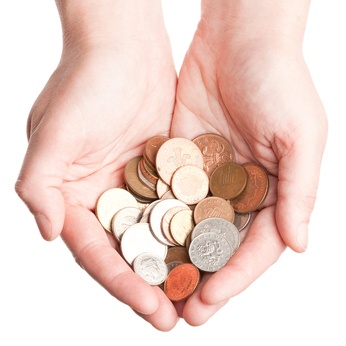- < Experiment 19
-
Experiment 20 v4
- Experiment 21 >
Playing the change game

Are you good at playing the change game?
Purpose
This experiment gives children an opportunity to practise estimating, halving numbers and counting money.
The child will learn how to estimate change by looking at a handful of coins.
You need to know
- how to add numbers in your head
- the values of different coins
You will need



Steps
-
Find as many coins as you can.
Get a selection of different values (1p, 5p, £1, etc.).
- Put all the coins in a container and mix them.
- Grab a handful of coins but keep your hand closed.
-
Turn your hand finger-side up and open it.
Try to estimate, as quickly as you can, the total value in pence of the coins in your hand.
Write down your estimate.

-
Count the actual value of the coins in pence.
Write down the actual value.
-
What is the difference in pence between your estimate and the actual value?
Write this down as your score.
Hint
The game is to score as few points as possible.
It is best played with several contestants. Have ten rounds of play. The winner is the person with the lowest score at the end.
You could ask an adult to be the referee, picking and showing the coins.
If your estimate is exactly right in any round, you can halve your score (rounding down)!
Questions
- How can you make sure the game is fair for all contestants?
- Why does the instruction about halving mention rounding?
-
Why do you think it says to round down instead of up?
Hint
Think about what would happen if your estimate was correct when you had 1 point already.
Expected answers
-
It is unfair if the person picking the coins is also a contestant because they will know roughly how many coins they picked and may even have looked at them.
It is also important that everyone has the same time to make their estimate. It's a good idea for the referee to show the coins to both contestants at once, and to close their hands again after a certain number of seconds.
-
If you have an odd score, halving it will give you a fraction.
For example, if your score was 7 then halving it would give 3.5.
By rounding it, you always get a whole number (e.g. 3).
-
If you were on 1 point, halving it gives 0.5.
If you round down, it goes to 0; if you round up it goes to 1, and you're back where you started.
So rounding down instead of up means you get some benefit even if you're only on one point.
Explore further (optional)
Think of some different ways of playing or scoring this game, to find out which you prefer to play.
Tips for further exploration
- Change the scoring so you don't get any points added if your estimate is within 20p of the actual value.
- Show the coins for a shorter and shorter time with each round.
- Add more coins for each round.
- Add some items like counters or marbles that bulk up the pile but don't have any value.
- The contestants can take as long as they need to make an estimate, but get a certain number of points added to their score for each second they take.
There are endless varieties to this game. Here are some possibilities:



